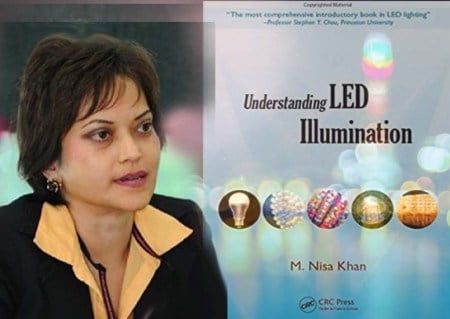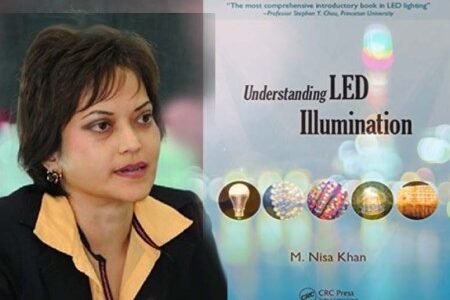5G is being rapidly rolled out globally, despite grave concerns among independent scientists over safety. Very little published evidence exists on the actual health risks. But one pioneering scientist, noted in Who’s Who as a top industry expert, offers an innovative new paper destined to be a benchmark in the quantification and identification of actual radiative properties from antennae.
Principia Scientific International (PSI) proudly presents this key study, authored by the eminent electrical engineering scientist, M. Nisa Khan, Ph.D., EE, who holds 10 patents in the field, and whose work is archived by the New York Times and the Wall Street Journal.
Dr Khan sets out a rigorous step-by-step process to mathematically derive the radiation strength distribution from an antenna’s surface, an astonishing breakthrough in this field of technology. Her analysis is especially remarkable as it meticulously employs the well-known Maxwell’s Equations and Gauss’ Laws.
Titled, ‘Novel Derivations and Validation of Near-field Electromagnetic Spatial Power Density Distribution and Propagation Functions for Flat Antennas,’ the full paper is open access, fully free to read, and we welcome reader comments below.
Speaking to me over a fascinating two-hour Skype interview Dr Khan explained that:
“Wireless capability in the usage of smartphones, personal mobile computers, drones, keyless and driver-less cars, remote printers and many other devices has become endemic and is here to stay. Devices are getting more capable over time in terms of transferring higher and higher amounts of voice, text, and video data among people and other entities with ever-increasing speed.”
But there is an elephant in the room of all this hi-tech success that this prominent international industry expert felt compelled to discuss. Dr Khan explained:
“While 5G has already been rolled out in several countries around the world there are very basic misunderstandings of how man-made, antenna-generated wireless signals, i.e., their electromagnetic energy distribution or radiation pattern, appear in space and how they propagate through space. This has never been very well understood or properly analyzed using rigorous science and mathematics.”
Dr Khan, who is a Senior Member of the Institute of Electrical and Electronics Engineers (IEEE) is a heavy-hitter in this field of science and cautioned me to consider that something crucial has been overlooked: safety.
Thankfully, some enlightened litigants have had initial success in exposing the failings of government bodies on this issue, as in an important case in which a U.S. Court Ruled FCC “Failed” Over 5G Safety Concerns.
Picking up on this issue, Principia Scientific International (PSI) has published numerous articles in recent years, as can be seen here, here, here and here.
But Dr Khan insists much more is still needed. She laments:
“The engineering design of cellphone and base-station antennas and wireless networks are not optimized for energy efficiency. Further, these new devices often produce dangerous amount of radiation close to the antennas and evidence is building that this is particularly harmful to a whole host of biological species.”
This problem is multi-fold. A lack of understanding and misinterpreting wireless radiation properties in space has led to inaccurate and non-repeatable signal strength measurements. Consequently, the results shown in many notable biological studies appear inconclusive.
Dr Khan directed my attention to what independent scientists are seeing; that the radiation strength measurements from Samsung and Apple smartphones were underestimated at first and many such phones already violate the maximum radiation strength set by the authorities.
She asks us to consider one important question:
“So, what is going on and what type of adverse effects from wireless radiation could we be subjected to now and in the future as exposure accumulates over time?”
Helping fellow independent scientists and engineers get a better handle on the facts is Dr Khan’s important new paper, which is especially significant because it presents a step-by-step process to mathematically derive the radiation strength distribution at the antenna surface. Khan’s analysis does this by starting from the well-known Maxwell’s Equations and Gauss’ Laws that established the electromagnetic theory in the late 1800’s.
In fact, the wave equation in quantum mechanics is also rooted from this establishment. So, why then does the physics and electrical engineering communities still miss the fundamental issues around electromagnetics and insist on using an erroneous approximation of radiation strength very far away when they never figured out exactly what this radiation pattern is very close to the antenna surface?
While radio-frequency (RF) simulations can produce a generic pattern for the radiation strength on the antenna surface, it only provides a relative profile meaning it fails to provide the physical radiation strengths in watts/square-meter/solid-angle, which must be a specific set of physical quantities over the whole antenna surface as these quantities vary over the entire antenna surface!
The answer, says Dr Khan, is that no one has been able to come up with an analytic formula or equation for this radiation strength profile on the antenna surface until this paper! The reason is that no one has ever solved this multi-dimensional finite problem analytically for a flat antenna structure that invariably requires using advanced calculus and analytic geometry, which now has been presented in this important paper.
Dr Khan is all in on her findings insisting that the content and results of this paper are fully correct. I asked her why she is so confident. She answered:
“Among other reasons, there are two compelling demonstrations that validate the paper. First, the paper shows for the first time why Lambert’s Cosine Law is correct. While this law has been widely used in lighting, imaging and display industries for over a century, no one ever proved Lambert’s Law! Not even Lambert himself! It is important to note that both RF and light (visible or not) are electromagnetic waves and are governed by Maxwell’s Equations. Therefore, the same electromagnetic principles hold true for both RF and optical domains.”
Secondly, Dr Khan added that the analytic equations derived in this paper are validated using well-established RF simulation software that has been in use for decades.
“Further, the optical equivalents of the analytic equations have been experimentally validated by the same author in 2019 and this study is published in a peer-reviewed IEEE journal!”
It is important to note that the laser theory was formulated as well as invented following the maser theory and practice. Prior to masers, RF scientists and engineers worked on antennas and wireless signal propagation through the atmosphere or space.
Dr Khan is emphatic on this point:
“These professionals very well knew that lasers, masers, and antennas have some directional properties meaning they are beams rather than the directionless radiation that comes from the sun showing spherical uniformity in space.”
So, what actually gave masers, lasers, LEDs, and antennas their directivity?
Dr Khan told me she has never heard anyone giving or knowing the answer despite her close professional and educational association with the pioneers of lasers, LEDs, and RF antennas and other devices! She fondly recalls her thesis adviser, Professor Robert J. Collins, curiously wondering,
“What makes the laser produce a pencil beam?”
Professor Collins invented the first ruby laser that produced a sharp pencil beam and demonstrated the oscillation behavior of a laser along with his colleagues at Bell Labs in the 1960’s. It is important to note that while Theodore Maiman deservingly gets the credit for the first ruby laser, his version never produced a sharp pencil beam showing oscillatory behavior that a very-narrow laser light beam invariably holds.
Dr Khan also recalls that Professor Collins challenged her to find the answer. It took her more than 20 years to find the answer. But, sadly, Professor Collins passed away a few years ago.
“So what makes a cellphone or a base-station RF antenna or an LED directive? The answer is that these all have flat surfaces or sufficiently flat surfaces!”
Dr Khan is emphatic that her paper shows that when Maxwell’s Equations and Gauss’ Divergence Theorem are applied to a finite-size flat antenna, the radiation strength profile on the surface of the antenna is similar to a Gaussian Function or a bell-shaped curve with a peak in the middle.
This peak occurs in the middle of the flat antenna and the larger the antenna size, the higher the peak strength. The peak strength, according to the derived formula, also increases with increasing input RF power that is usually a sinusoidal RF signal feed. The paper then derives the formula for how this peaked Gaussian-like profile of the wireless beam propagates in space maintaining the peaked pattern along the direction of the beam. What this really means is that the radiation power density is non-uniform in space as the peak only occurs along the propagation axis.
Therefore, if a detector is placed in a particular location along the beam, it will average out the radiation strength or intensity falling on the detector plane.
Dr Khan cautioned that:
“This means that if a cellphone radiation falls on a mouse in a lab for biological studies, only a small part of the rat’s body will experience the peak radiation and other parts of the body will experience a significantly less radiation intensity; and the average recorded intensity falling on the rat is neither the peak intensity, nor the minimum intensity that falls on different parts of the rat’s body! The same situation occurs inside the brain of someone when someone holds a working cellphone against his head!”
We would be wise to pay careful heed to an expert of Dr. Khan’s caliber, with a long and distinguished career at the forefront of this fast-evolving science.
In conclusion, since the paper presents accurate and novel analytic formulas for radiation pattern on flat cellphone or base-station antenna surfaces, this new work stands to revolutionize and simplify the fields of near-field radiometry and photometry, which have been very complicated and confusing areas of studies for a very long time.
Source: https://principia-scientific.com/led-industry-expert-shines-new-light-on-5g-safety-mystery/




